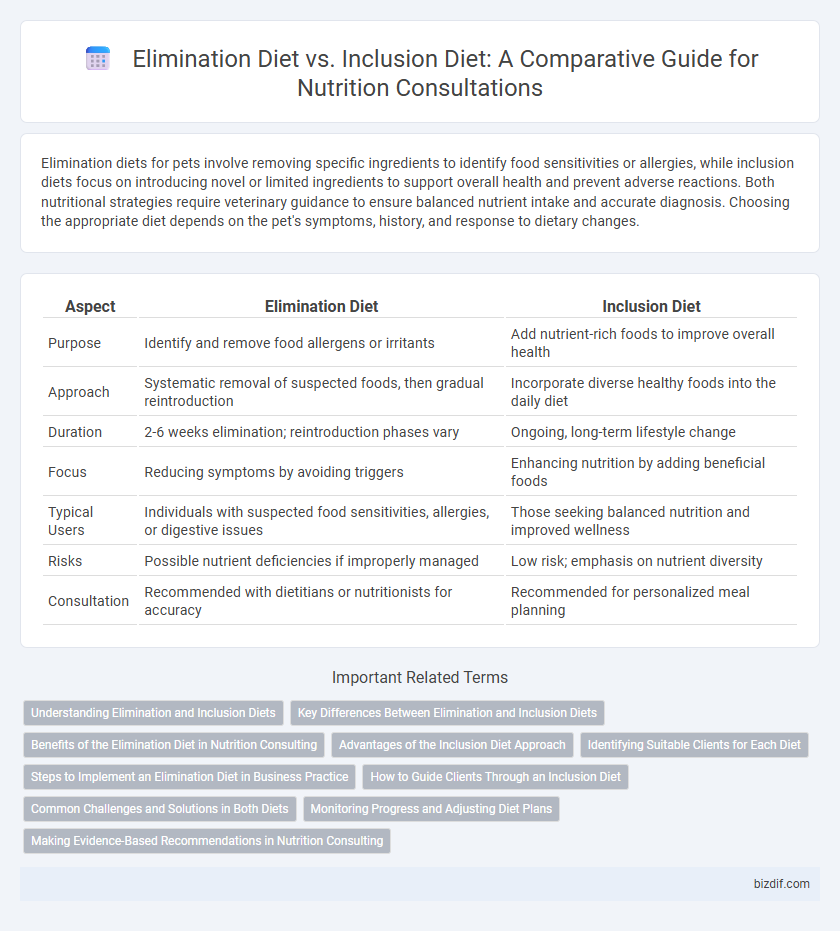Elimination diets for pets involve removing specific ingredients to identify food sensitivities or allergies, while inclusion diets focus on introducing novel or limited ingredients to support overall health and prevent adverse reactions. Both nutritional strategies require veterinary guidance to ensure balanced nutrient intake and accurate diagnosis. Choosing the appropriate diet depends on the pet's symptoms, history, and response to dietary changes.
Table of Comparison
| Aspect | Elimination Diet | Inclusion Diet |
|---|---|---|
| Purpose | Identify and remove food allergens or irritants | Add nutrient-rich foods to improve overall health |
| Approach | Systematic removal of suspected foods, then gradual reintroduction | Incorporate diverse healthy foods into the daily diet |
| Duration | 2-6 weeks elimination; reintroduction phases vary | Ongoing, long-term lifestyle change |
| Focus | Reducing symptoms by avoiding triggers | Enhancing nutrition by adding beneficial foods |
| Typical Users | Individuals with suspected food sensitivities, allergies, or digestive issues | Those seeking balanced nutrition and improved wellness |
| Risks | Possible nutrient deficiencies if improperly managed | Low risk; emphasis on nutrient diversity |
| Consultation | Recommended with dietitians or nutritionists for accuracy | Recommended for personalized meal planning |
Understanding Elimination and Inclusion Diets
Elimination diets identify food sensitivities by removing potential allergens for several weeks before gradually reintroducing them while monitoring symptoms. Inclusion diets emphasize incorporating a variety of nutrient-dense foods to support overall health and prevent deficiencies. Both approaches require careful planning and professional guidance to ensure balanced nutrition and accurate assessment of dietary impacts.
Key Differences Between Elimination and Inclusion Diets
Elimination diets systematically remove potential allergens or irritants from the diet to identify food sensitivities, whereas inclusion diets focus on adding nutrient-dense foods to enhance health and prevent deficiencies. Elimination diets require strict monitoring and reintroduction phases to pinpoint problematic foods, while inclusion diets emphasize the consistent integration of beneficial ingredients such as fruits, vegetables, and whole grains. Understanding these key differences aids nutrition professionals in tailoring dietary strategies to manage allergies, intolerances, or overall wellness goals effectively.
Benefits of the Elimination Diet in Nutrition Consulting
Elimination diets offer significant benefits in nutrition consulting by identifying specific food sensitivities and allergies, enabling personalized dietary plans that improve digestive health and reduce inflammation. This targeted approach helps clients avoid unnecessary restrictions, enhancing nutrient absorption and overall well-being. Nutrition professionals use elimination diets to uncover hidden triggers for symptoms such as bloating, headaches, and fatigue, which facilitates more accurate diagnosis and effective dietary recommendations.
Advantages of the Inclusion Diet Approach
The Inclusion Diet approach promotes a more balanced and sustainable way of eating by focusing on adding nutrient-dense foods rather than restricting options, which helps prevent nutritional deficiencies common in elimination diets. It supports gut health by encouraging diversity in food choices, leading to improved digestion and reduced inflammation. This method is especially beneficial for long-term dietary adherence, enhancing overall wellness and reducing the risk of disordered eating patterns often seen with strict elimination protocols.
Identifying Suitable Clients for Each Diet
Elimination diets are ideal for clients experiencing unclear food sensitivities, allergies, or gastrointestinal issues, as they systematically remove and reintroduce potential triggers to identify intolerances. Inclusion diets suit individuals seeking to enhance nutrient diversity and address deficiencies by incorporating a wide range of nutrient-dense foods, promoting overall health and well-being. Accurate client assessment, including medical history and symptom tracking, is crucial to determine which dietary approach best supports personalized health goals.
Steps to Implement an Elimination Diet in Business Practice
Implementing an elimination diet in business practice involves systematically removing common allergens and potential irritants such as gluten, dairy, nuts, and soy for 2-4 weeks, followed by gradual reintroduction to identify triggers. Detailed client tracking through food diaries and symptom logs enhances accuracy in pinpointing adverse reactions, facilitating tailored nutrition plans. Collaborating with dietitians ensures safe, evidence-based protocols while optimizing client outcomes and business credibility.
How to Guide Clients Through an Inclusion Diet
Guiding clients through an inclusion diet involves systematically reintroducing a variety of foods to identify those that support optimal health while monitoring for any adverse reactions. Emphasize detailed food journaling and symptom tracking to ensure accurate assessment of each food's impact on digestion, energy levels, and overall well-being. Collaborate closely with clients to customize the diet based on tolerance, nutritional needs, and lifestyle factors, promoting sustainable and balanced eating habits.
Common Challenges and Solutions in Both Diets
Elimination diets often present challenges such as nutrient deficiencies and difficulty maintaining variety, which can be addressed by careful planning and consultation with a registered dietitian to ensure balanced intake. Inclusion diets may struggle with identifying trigger foods and managing portion control, where keeping a detailed food diary and gradual food reintroduction helps pinpoint sensitivities without compromising overall nutrition. Both approaches benefit from personalized guidance, patient education, and monitoring to optimize dietary adherence and long-term health outcomes.
Monitoring Progress and Adjusting Diet Plans
Monitoring progress in elimination diets involves systematically reintroducing foods while tracking symptoms to identify triggers and ensure accurate diagnosis of intolerances or allergies. Inclusion diets focus on gradually incorporating nutrient-dense foods with ongoing assessment to optimize nutrient intake and improve overall health outcomes. Adjusting diet plans requires detailed symptom logs, nutrient analysis, and regular consultations to tailor interventions that balance symptom management and nutritional adequacy.
Making Evidence-Based Recommendations in Nutrition Consulting
Elimination diets systematically remove specific foods to identify potential allergens or intolerances, supported by clinical evidence highlighting their role in diagnosing adverse food reactions. Inclusion diets emphasize the addition of nutrient-rich, diverse foods to enhance overall dietary quality and support long-term health, backed by epidemiological studies linking dietary variety with reduced chronic disease risk. Nutrition consultants rely on current evidence-based guidelines to tailor these approaches, ensuring personalized dietary plans that efficiently address individual health concerns and optimize nutritional status.
Elimination Diet vs Inclusion Diet Infographic

 bizdif.com
bizdif.com